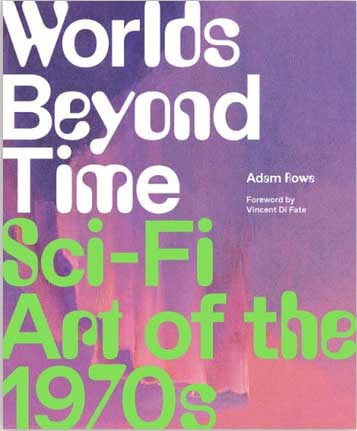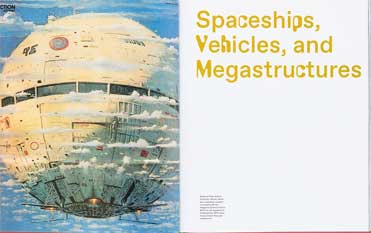
Worlds Beyond Time. Sci-Fi Art of the 1970s, Adam Rowe
(224pp, hbck, £30, Abrams)
Back in the day, that is during the late 1970s, a visit to Dark They Were and Golden-Eyed bookshop in St. Anne’s Court, London, was to find oneself in an alternative universe where punk and hippy and countercultural zines piled on tables, fought for attention with shelves crammed full of American science fiction books, comic books and mysterious titles full of earth magic, leylines, spells and cosmic mysteries.
Bug-eyed monsters, mystical temples and caves, magicians, mutants and – of course – bloody hobbits and dwarves, were everywhere. Alien cities were home to spaceships that were bigger than London itself, and everyone was armed to the teeth, despite claiming ‘to come in peace’. Space helmets, skulls, undressed Amazonian spacewomen, giant cats, intergalactic armies and space colonies were de rigeur, space travel, biotech and blissed-out planetary landscapes the norm. After all, man had landed on the moon, drugs had expanded human consciousness, and the future was coming soon.

But the future didn’t come quite as expected, and most of what we imagined stayed trapped in the pages or covers of all those books. The wonderful Science Fiction Monthly published by NEL ceased publication, although they released an oversized paperback anthology of art they had previously featured, a copy of which I still own; and in 1981 Dark They Were and Golden Eyed closed up shop, never to return, time travel notwithstanding. Science Fiction has, of course, continued to go in and out of literary and cultural fashion, although the more experimental end still remains pretty much ‘underground’ (along with its cousins in contemporary fiction), as opposed to the sub-Tolkien sword and sorcery nonsense which features heavily on publishers’ ‘Fantasy’ lists. Only a few authors, such as William Burroughs, Michael Moorcock and J.G. Ballard, seemed to surf critical opinion into notional mainstream acceptance. And only a few specialist shops are still functioning, although I suspect this is mostly due to sales of t-shirts, memorabilia and plastic crap than the books hidden away in their basements.
I was delighted to receive a copy of Worlds Beyond Time, not just for nostalgic reasons, but because it is a serious attempt to map the mostly forgotten art of the decade. Adam Rowe offers a succinct history of science fiction before diving into first of many sections in his book: ‘The Abstract, Surreal, and Otheworldly’, ‘Spaceships, Vehicles and Megastructures’, ‘Sci-Fi Cities and Landscapes’, ‘Life in the Future[s]’ and ‘Fantasy Realms’ among them. These are the subdivided again into (mostly) double page spreads by specific artist or depictions of named topics and themes, as well as an introduction to each section.
Rowe is witty and informed, and thankfully not too geeky, but I remain fairly unconvinced by his taxonomy. Some of that is taste of course, and some of it may be due to copyright permissions or a lack of, but I wouldn’t have wasted room on the cover illustration for a Queen album, or the retro covers of Creepy and Eerie magazines. I might have ignored Close Encounters, Star Wars and Star Trek images too, since there were far more interesting and stranger films and science fiction TV around. There are some strange (my daughter would say ‘random’) groupings of work here, such as ‘Gunfights in Space’ and ‘Skull Planets’ and a distinct lack of some of more pop art work by the likes of David Pelham who did striking J G Ballard covers for Penguin.

I also wish there was more space given to the art itself. Too many pages have tiny thumbnail images of book covers on, with more room given to Rowe’s chatty summaries than relevant details. I think in the end there’s a conflation of two different books here: a celebration of art, and an encyclopedia or dictionary of science fiction art, with entries for artists, themes and examples of book jackets.
It’s difficult isn’t it? I mean who am I to say ‘don’t do it like that?’ (The obvious answer is ‘go and do your own book then.’) This book is great, but it has made me aware that I actually prefer more surreal or strange science fiction art, perhaps from the 60s rather than the 70s; and that I don’t like the more cartoony, comic or fantasy end of things when it comes to science fiction illustration and covers (well, books too). Also, that science fiction art isn’t a self-contained bubble, all this art exists or existed in a web of social, cultural and historical ideas and events. Sometimes Rowe links the images to things like the moon landing or NASA’s activities, but not very often, or not often enough. I know it’s not a sociology book but I’d like to know why even the supposedly logical Spock and Captain Kirk tend to shoot the aliens they encounter, despite their declaration ‘to explore strange new worlds, and seek out new life and new civilizations’. There were dissenting and critical artists at work, opposing the party line about technological utopias and the conquest of space – including Ian Miller, whose work is included – but you wouldn’t think so from this anthology.
Vincent Di Fate is more optimistic and upbeat in his Foreword, so let me give the (almost) last word to him:
May this book be among the first of many to draw attention
to one of the true, yet largely undiscovered treasures of
human thought. All great works of art, written, drawn, sung
or otherwise, aspire to remind us of our greater worth—our
fundamental humanity. And what better dreams might we
have than dreams of a brighter and better tomorrow?
I’m not sure that all these images show ‘a brighter and better world’, there are too many dystopias and post-apocalyptic scenes here, not to mention warmongering robots and starship troopers, but never mind. We can still dream.
Rupert Loydell
More details and images for Worlds Beyond Time can be found at the publisher’s website: https://www.abramsbooks.com/product/worlds-beyond-time_9781419748691/
Adam Rowe’s 70s Sci Fi Art, is at https://70sscifiart.tumblr.com/and other social media platforms
Some issues of Science Fiction Monthly are available to view at the Internet Archive: https://archive.org/details/texts?&and[]=%22science%20fiction%20monthly%22

Nice memories of a faded glory, the shop had moved from premises in Berwick Street. As I recall the St. Anne’s Court was double fronted and as you say full of joy. Neil.
Comment by Neil Houlton on 1 July, 2023 at 4:42 pm